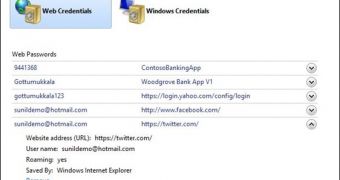When made available next year, Windows 8 will bring along a series of enhancements that are meant at improving the identity protection that people benefit from.
Given the fact that we’re living in a connected world these days, the risks of identity theft are higher, and the next PC platform from the Redmond-based company is meant to ensure that users are better protected than before.
The software giant was focused on ensuring the users will benefit from a both ease and increased safety when it comes to the management of their digital identities.
One of the underlying reasons for this was the large number of accounts that a user typically has (in the United States, the number rises to 25, on average).
And since people tend to use the same password on more accounts (remembering a whole lot of passwords is not always a great solution), the risk of having one’s digital identity compromised when one account is hacked increases.
Of course, complex, unique passwords for each visited website can prove a great option for remaining safe, but there are also other options that users should take into consideration, Microsoft’s Dustin Ingalls notes in a recent post.
“With Windows 8, we provide support for both the safe storage of username/password combinations, and technology to support alternate authentication; that is, we try to make it easier for you to enhance the security of your passwords, and easier to use newer and stronger techniques for protecting your digital identity,” he says.
Users should consider improving both the security and the usability of their passwords, Ingalls explains. They should start with making sure their PCs are free of malware, which should keep them away from phishing and keylogging. They should also ensure they use strong, complex passwords for each account.
“Windows 8 simplifies the task of managing unique and complex passwords in two important ways. The first is by providing a way to automatically store and retrieve multiple account names and passwords for all the websites and applications you use, and do so in a protected manner,” he notes.
“Internet Explorer 10 uses the credentials that we store to remember names and passwords for websites you visit (if you choose). In addition, anyone building a Metro style app can use a direct API to securely store and retrieve credentials for that app.”
The second security enhancement that Windows 8 comes with was detailed back in September, and refers to the use of a Windows Live ID for signing into Windows 8. This enables users to sync credentials from other the Windows 8 PCs that have been register as “Trusted PCs.”
“Windows enables you to set your password for each account to something that is both complex and unique; since Windows 8 will automatically submit the credential on your behalf, you’ll never need to remember it yourself,” Dustin Ingalls continues.
Just as shown in the screenshot above, users can view a password at any time through going to the credential manager one any of the aforementioned Trusted PCs.

 14 DAY TRIAL //
14 DAY TRIAL //